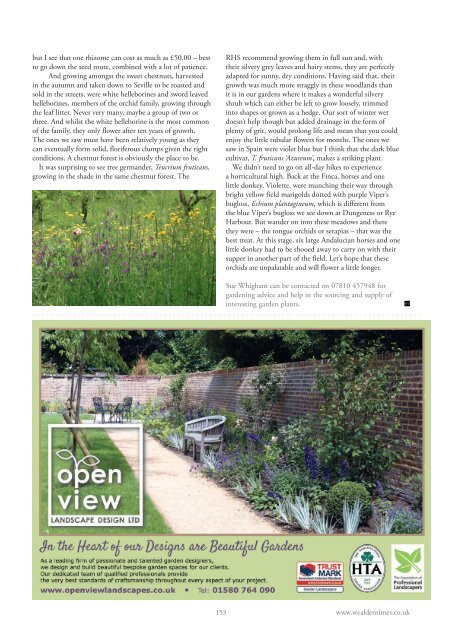Wealden Times | WT172 | June 2016 | Kitchen & Bathroom supplement inside
Wealden Times - The lifestyle magazine for the Weald
Wealden Times - The lifestyle magazine for the Weald
Create successful ePaper yourself
Turn your PDF publications into a flip-book with our unique Google optimized e-Paper software.
ut I see that one rhizome can cost as much as £50.00 – best<br />
to go down the seed route, combined with a lot of patience.<br />
And growing amongst the sweet chestnuts, harvested<br />
in the autumn and taken down to Seville to be roasted and<br />
sold in the streets, were white helleborines and sword leaved<br />
helleborines, members of the orchid family, growing through<br />
the leaf litter. Never very many, maybe a group of two or<br />
three. And whilst the white helleborine is the most common<br />
of the family, they only flower after ten years of growth.<br />
The ones we saw must have been relatively young as they<br />
can eventually form solid, floriferous clumps given the right<br />
conditions. A chestnut forest is obviously the place to be.<br />
It was surprising to see tree germander, Teucrium fruticans,<br />
growing in the shade in the same chestnut forest. The<br />
RHS recommend growing them in full sun and, with<br />
their silvery grey leaves and hairy stems, they are perfectly<br />
adapted for sunny, dry conditions. Having said that, their<br />
growth was much more straggly in these woodlands than<br />
it is in our gardens where it makes a wonderful silvery<br />
shrub which can either be left to grow loosely, trimmed<br />
into shapes or grown as a hedge. Our sort of winter wet<br />
doesn’t help though but added drainage in the form of<br />
plenty of grit, would prolong life and mean that you could<br />
enjoy the little tubular flowers for months. The ones we<br />
saw in Spain were violet blue but I think that the dark blue<br />
cultivar, T. fruticans ‘Azureum’, makes a striking plant.<br />
We didn’t need to go on all-day hikes to experience<br />
a horticultural high. Back at the Finca, horses and one<br />
little donkey, Violette, were munching their way through<br />
bright yellow field marigolds dotted with purple Viper’s<br />
bugloss, Echium plantagineum, which is different from<br />
the blue Viper’s bugloss we see down at Dungeness or Rye<br />
Harbour. But wander on into these meadows and there<br />
they were – the tongue orchids or serapias – that was the<br />
best treat. At this stage, six large Andalucian horses and one<br />
little donkey had to be shooed away to carry on with their<br />
supper in another part of the field. Let’s hope that these<br />
orchids are unpalatable and will flower a little longer.<br />
Sue Whigham can be contacted on 07810 457948 for<br />
gardening advice and help in the sourcing and supply of<br />
interesting garden plants.<br />
153 www.wealdentimes.co.uk<br />
OpenviewLandscapeDesign<strong>WT172</strong>.indd 1 12/05/<strong>2016</strong> 14:10


















